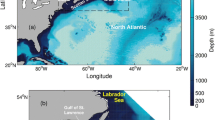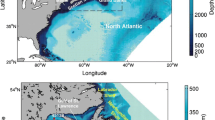Abstract
Wave climate plays an important role in the air-sea interaction over marginal seas. Extreme wave height provides fundamental information for various ocean engineering practices, such as hazard mitigation, coastal structure design, and risk assessment. In this paper, we implement a third generation wave model and conduct a high-resolution wave hindcast over the East China Sea to reconstruct a 15-year wave field from 1988 to 2002 for derivation of monthly mean wave parameters and analysis of extreme wave conditions. The numerical results of the wave field are validated through comparison with satellite altimetry measurements, low-resolution reanalysis, and the ocean wave buoy record. The monthly averaged wave height and wave period show seasonal variation and refined spatial patterns of surface waves in the East China Sea. The climatological significant wave height and mean wave period decrease from the open ocean in the southeast toward the continental area in the northwest, with the pattern generally following the bathymetry. Extreme analysis on the significant wave height at the buoy station indicates the hindcast data underestimate the extreme values relative to the observations. The spatial pattern of extreme wave height shows single peak emerges at the southwest of Ryukyu Island although a wind forcing with multi-core structure at the extreme is applied.
Similar content being viewed by others
References
Atlas R, Hoffman R N, Ardizzone J, Leidner S M, Jusem J C, Smith D K, Gombos D. 2011. A cross-calibrated, multiplatform ocean surface wind velocity product for meteorological and oceanographic applications. Bull Amer Meteorol Soc, 92: 157–174
Bai Y F, Cheung K F. 2013. Dispersion and nonlinearity of multi-layer non-hydrostatic free-surface flow. J Fluid Mech, 726: 226–260
Battjes J A, Janssen J P F M. 1978. Energy loss and set-up due to breaking of random waves. In: 16th International Conference on Coastal Engineering, American Society of Civil Engineers. Hamburg. 569–587
Brodtkorb P A, Johannesson P, Lindgren G, Rychlik I, Rydén J, Sjö E. 2000. WAFO—A Matlab toolbox for the analysis of random waves and loads. In: 10th International Offshore and Polar Engineering Conference ISOPE. Seattle, 3: 343–350
Caires S, Sterl A. 2005. A new nonparametric method to correct model data: Application to significant wave height from the ERA-40 Re-Analysis. J Atmos Ocean Technol, 22: 443–459
Cavaleri L, Alves J H G M, Ardhuin F, Babanin A, Banner M, Belibassakis K, Benoit M, Donelan M, Groeneweg J, Herbers T H C, Hwang P, Janssen P A E M, Janssen T, Lavrenov I V, Magne R, Monbaliu J, Onorato M, Polnikov V, Resio D, Rogers W E, Sheremet A, McKee Smith J, Tolman H L, van Vledder G, Wolf J, Young I. 2007. Wave modelling—The state of the art. Prog Oceanogr, 75: 603–674
Chen G, Bi S W, Ezraty R. 2004. Global structure of extreme wind and wave climate derived from TOPEX altimeter data. Int J Remote Sens, 25: 1005–1018
Chen Y P, Xie D M, Zhang C K, Qian X S. 2013. Estimation of long-term wave statistics in the East China Sea. J Coastal Res, 65: 177–182
Cooper C K, Forristall G Z. 1997. The use of satellite altimeter data to estimate the extreme wave climate. J Atmos Ocean Technol, 14: 254–266
Cui H, He H L, Liu X H, Li Y. 2012. Effect of oceanic current on typhoonwave modeling in the East China Sea. Chin Phys B, 21: 109201
Dee D P, Uppala S M, Simmons A J, Berrisford P, Poli P, Kobayashi S, Andrae U, Balmaseda M A, Balsamo G, Bauer P, Bechtold P, Beljaars A C M, van de Berg L, Bidlot J, Bormann N, Delsol C, Dragani R, Fuentes M, Geer A J, Haimberger L, Healy S B, Hersbach H, Hólm E V, Isaksen L, Kållberg P, Köhler M, Matricardi M, McNally A P, Monge-Sanz B M, Morcrette J J, Park B K, Peubey C, de Rosnay P, Tavolato C, Thépaut J N, Vitart F. 2011. The ERA-Interim reanalysis: Configuration and performance of the data assimilation system. Q J R Meteorol Soc, 137: 553–597
Ebuchi N, Kawamura H. 1994. Validation of wind speeds and significant wave heights observed by the TOPEX altimeter around Japan. J Oceanogr, 50: 479–487
Falqués A. 2006. Wave driven alongshore sediment transport and stability of the Dutch coastline. Coastal Eng, 53: 243–254
Hasselmann S, Hasselmann K, Allender J H, Barnett T P. 1985. Computations and parameterizations of the nonlinear energy transfer in a gravity-wave specturm. Part II: Parameterizations of the nonlinear energy transfer for application in wave models. J Phys Oceanogr, 15: 1378–1391
He H L, Chen D. 2011. Effects of surface wave breaking on the oceanic boundary layer. Geophys Res Lett, 38: L07604
He H L, Xu Y. 2016. Wind-wave hindcast in the Yellow Sea and the Bohai Sea from the year 1988 to 2002. Acta Oceanol Sin, 35: 46–53
Huang Y, Yin B S, Perrie W, Hou Y J. 2008. Responses of summertime extreme wave heights to local climate variations in the East China Sea. J Geophys Res, 113: C09031
Kim H S, Kim J H, Ho C H, Chu P S. 2010. Pattern classification of typhoon tracks using the Fuzzy c-means clustering method. J Clim, 24: 488–508
Li S, Li M, Gerbi G P, Song J B. 2013. Roles of breaking waves and Langmuir circulation in the surface boundary layer of a coastal ocean. J Geophys Res-Oceans, 118: 5173–5187
Li M K, Hou Y J. 2005. Simulating wind-wave field of the East China Seas with QuikSCAT/NCEP blended wind and WAVEWATCH (in Chinese). Mar Sci, 29: 9–12
Liu B, Liu H Q, Xie L A, Guan C L, Zhao D L. 2011. A coupled atmosphere-wave-ocean modeling system: Simulation of the intensity of an idealized tropical cyclone. Mon Weather Rev, 139: 132–152
Moon I J, Ginis I, Hara T. 2004. Effect of surface waves on Charnock coefficient under tropical cyclones. Geophys Res Lett, 31: L20302
Palutikof J P, Brabson B B, Lister D H, Adcock S T. 1999. A review of methods to calculate extreme wind speeds. Meteorol App, 6: 119–132
Paskyabi M B, Fer I, Jenkins A D. 2012. Surface gravity wave effects on the upper ocean boundary layer: Modification of a one-dimensional vertical mixing model. Cont Shelf Res, 38: 63–78
Qiao F L, Song Z Y, Bao Y, Song Y J, Shu Q, Huang C J, Zhao W. 2013. Development and evaluation of an Earth System Model with surface gravity waves. J Geophys Res-Oceans, 118: 4514–4524
Semedo A, Sušelj K, Rutgersson A, Sterl A. 2011. A global view on the wind sea and swell climate and variability from ERA-40. J Clim, 24: 1461–1479
Song J B. 2009. The effects of random surface waves on the steady Ekman current solutions. Deep-Sea Res Part I-Oceanogr Res Pap, 56: 659–671
Song J B, Fan W, Li S, Zhou M. 2015. Impact of surface waves on the steady near-surface wind profiles over the ocean. Bound-Layer Meteorol, 155: 111–127
Sterl A, Komen G J, Cotton P D. 1998. Fifteen years of global wave hindcasts using winds from the European Centre for Medium-Range Weather Forecasts reanalysis: Validating the reanalyzed winds and assessing the wave climate. J Geophys Res, 103: 5477–5492
Stopa J E, Cheung K F. 2014. Periodicity and patterns of ocean wind and wave climate. J Geophys Res-Oceans, 119: 5563–5584
Tolman H L, Chalikov D. 1996. Source terms in a third-generation wind wave model. J Phys Oceanogr, 26: 2497–2518
Tolman H L, Balasubramaniyan B, Burroughs L D, Chalikov D V, Chao Y Y, Chen H S, Gerald V M. 2002. Development and implementation of wind-generated ocean surface wave modelsat NCEP. Weather Forecast, 17: 311–333
Wang H L, Yang Y Z, Sun B N, Shi Y F. 2017. Improvements to the statistical theoretical model for wave breaking based on the ratio of breaking wave kinetic and potential energy. Sci China Earth Sci, 60: 180–187
Wang J, Dong C, He Y. 2016. Wave climatological analysis in the East China Sea. Cont Shelf Res, 120: 26–40
WAMDI Group. 1988. The WAM model—A third generation ocean wave prediction model. J Phys Oceanogr, 18: 1775–1810
Xu Y, Bi F, Song J B, He H L. 2017a. The temporal and spatial variations in the Pacific wind and wave fields for the period 2002–2011. Acta Oceanol Sin, 36: 26–36
Xu Y, He H L, Song J B, Hou Y J, Li F N. 2017b. Observations and modeling of typhoon waves in the South China Sea. J Phys Oceanogr, 47: 1307–1324
Xu Y Q, Yin B S, Yang D Z, Cheng M H. 2005. Study of wave numerical model in East China Sea (in Chinese). Mar Sci, 29: 42–47
Young I R. 1994. Global ocean wave statistics obtained from satellite observations. Appl Ocean Res, 16: 235–248
Young I R. 1999. Seasonal variability of the global ocean wind and wave climate. Int J Climatol, 19: 931–950
Zhao X X, Hou Y J, Li M K, Qi P. 2006. Analysis on monthly-averaged distribution of sea surface wind and wave over the seas southeast of Asia using ERS-2 scatterometer data. Chin J Ocean Limnol, 24: 97–102
Acknowledgements
The authors would like to thank the SOED HPCC for their computational support, and WAFO group for supplying the code (http://www.maths.lth.se/matstat/wafo/). The CCMP wind product was provided by Earth Science Enterprise (ESE) of National Aeronautics and Space Administration (NASA). TP satellite significant wave height was downloaded from Jet Propulsion Laboratory of NASA (https://www.jpl.nasa.gov/). Comments and suggestions provided by anonymous reviewers are greatly appreciated. This work was supported by the National Natural Science Foundation of China (Grant Nos. 41476021, 41576013 & 41321004), the National High Technology Research and Development Program of China (Grant No. 2013AA122803), and National Program on Global Change and Air-Sea Interaction (Grant No. GASI-IPOVAI-04).
Author information
Authors and Affiliations
Corresponding author
Rights and permissions
About this article
Cite this article
He, H., Song, J., Bai, Y. et al. Climate and extrema of ocean waves in the East China Sea. Sci. China Earth Sci. 61, 980–994 (2018). https://doi.org/10.1007/s11430-017-9156-7
Received:
Revised:
Accepted:
Published:
Issue Date:
DOI: https://doi.org/10.1007/s11430-017-9156-7




